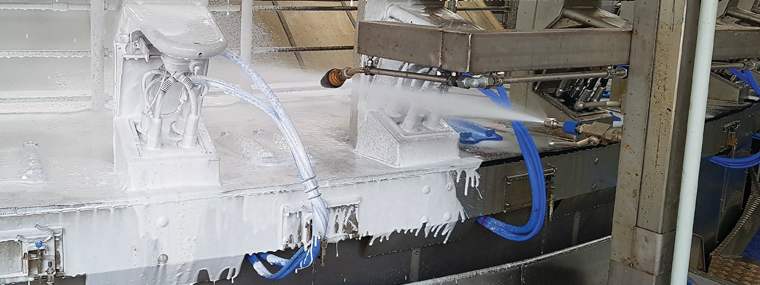
A Gentler Approach—Cleaning with Foam
By Diane M. Calabrese / Published August 2020

Not all dirt is alike. Particles from dust to organic debris range in size and composition. Yes, the particles can all be attacked with the same broad spray or brush. Or, a more selective approach—often a gentler one—can be taken. The approach is foam cleaning.
Cleaning with foam is a corollary of separating with foam. Industrial processes have long used foam as a mechanism for separation, which is called froth flotation (and other names, such as foam separation).
In industry, it may be just particles of one type that must be removed. A reagent that will selectively coat the particles and make them water repellent is added to an aqueous suspension. When air is bubbled through the suspension, coated particles attach to air bubbles and rise to the surface where they can be removed as froth.
When cleaning with foam, a similar principle is at work. Dirt particles are coated and buoyed by air and detergent bubbles (the foam), which can then be rinsed away. In cleaning with foam, the twist comes in that the foam is applied. (In the industrial process, it is made when air is bubbled through the suspension.)
Interest in cleaning with foam has been growing for years. Foam makes coverage easy to verify. And in the whole, it reduces the amount of chemical used. (There is no second guessing about whether an area had an application because the foam is visible.) In recent months, hospitals have been increasingly mandating the use of foam cleaners for hand washing and for cleaning surfaces.
“When disinfecting surfaces, using foam is ideal,” says Jim Sheperd, general manager of Suttner America Company in Dubuque, IA. “There are multiple benefits of using foam in this application. First, the dwell time, or the time the foam hangs on the surface, ensures the disinfectant has time to do the job.”
And Sheperd enumerates the other plusses for us. “Secondly, when using foam, you can see where you sprayed to make sure you have covered the surface properly,” he says. “Lastly, foaming saves you in chemical costs; you can use about half of the chemicals when foaming than when straight spraying the chemical.”
There’s also that assurance of coverage. “When straight spraying the chemical—without foam—you tend to overspray to ensure you covered the surface because the clear disinfectant is not as easily seen where you sprayed, thus wasting the chemical,” explains Sheperd.
The big positives in using foam to clean do not mean that all misconceptions about cleaning with it have been dispelled. The more understanding there is regarding the nature of foam cleaning, the more easily the concerns will be vanquished.
“Some think that foam will reduce the effectiveness of the chemical,” says Linda Chambers, brand and sales manager at Georgia Chemical Equipment in Norcross, GA. “But that is only true if too much foam is used and the chemical gets trapped up in the foam away from the surface and gets rinsed off before it can get back down to the surface to work.”
Misconceptions also exist among foam enthusiasts. They, too, must be corrected.
“Some tend to think it is best to have the most foam possible,” says Chambers. “In reality, having just enough foam to carry and hold the chemical is what you want.”
Foam cleaning really has the edge in a number of settings. “One is using foam for roof washing where contractors have the need for wanting their roof wash, including sodium hypochlorite, to stay in contact with the roof shingles as long as possible before rinsing,” says Chambers.
“Another is when washing stucco or other surfaces that have a lot of texture,” says Chambers. “Using just a regular liquid wash could just skate over the surface missing pockets, nooks, and crannies. In contrast, cleaners in a foaming product can get up into those areas to allow thorough cleaning.”
Chambers reminds us that foam has utility beyond cleaning. “Using foam to apply chemical to vertical wood surfaces, like wood stripper on railing spindles, is one example,” says Chambers.
Using foam to apply chemicals also lessens the amount of chemical that becomes airborne. Reducing the likelihood and the amount of chemicals that are aerosolized in any setting promotes safety.
Contractors can purchase attachments for pressure washers that act as foamers (foam cannons) or foam enhancers (bump up the volume of foam). Talking with distributors about options in the context of the type of cleaning or surface preparation being done is the starting place for a good match between equipment and chemical.
Foam Adopters
The extra time—or increased dwell time—that foam allows for chemical to meet particles is a big asset in the toughest cleaning projects. Among them are facilities that process food.
The movie, The Silver Horde (1930), depicted in near-documentary format the netting and canning of Alaskan salmon. Anyone who watches the film today will not be able to stop thinking about “botulism”—the illness caused by clostridium that produces a human neurotoxin. (The film actually focuses on a love triangle, but the fish and the ingenuity in the seamless net-to-can process are what hold the viewer’s interest.)
Jump to 2020. Cleaning in food processing plants is a high-priority endeavor. From clostridium to E. coli to salmonella, the goal is to keep illness-causing microbes away from food and consumers.
Foam cleaning is used throughout the food industry on surfaces and equipment. Foam covers thoroughly, including recessed areas and junctures. Coverage can be documented by imaging, if necessary (e.g. after incidence of a foodborne illness).
Food facilities as different as abattoirs (once simply slaughterhouses) and greenhouses benefit from foam cleaning. The relative ease with which foam clings to vertical surfaces slated for cleaning makes it a great asset in such places.
Chicken coops and transport coops can harbor fecal matter laden with salmonella or other bacteria. In turn, the bacteria can contaminate the chickens and then carcasses.
Finding the optimal way to clean coops is an active area of research. Studies of foam cleaning, including application of disinfectant, versus power washing and an application of disinfectant give the advantage to the foam. The foam can, apparently, get into the smallest imperfections in the wire of the cages.
In the poultry industry, the applicator for foam in some studies is a compressed air foam system (CAFS), or essentially a firefighting apparatus. Pressure washers are used for rinsing.
Low pressure foam application has been demonstrated to be the best method of cleaning food processing lines. It eliminates more of the bacteria, such as listeria, E. coli, and salmonella, that can be carried into products than does conventional cleaning. (Bacteria like listeria do not need much of a medium, or food source, to start reproducing rapidly. A biofilm left from incomplete cleaning will do.)
Car washes value foam for pre-washing. It spares the paint from abrasion (in scrubbing) even as it lifts off larger dirt particles, which are then washed away with a pre-rinse. Many car washes offer customers a choice of standard wash or pre-wash foam followed by standard wash.
Farm equipment, covered as it is with soil, insects, diesel, and fertilizers, is another target of foam. Manufacturers offer foam cleaners tailored to the type of residue that must be removed.
Foam cleaning applications continue to grow. In 2018, AeroCore Technologies demonstrated the use of a foam cleaner on a jet engine.
As good as results are with foam cleaners, they do not happen by chance. Operators of equipment must be well versed in the use of the equipment and the chemicals. Over-application of foam diminishes the benefits of using it. It means that more water must be used to rinse and more chemical is used (unnecessarily).
Foam itself is not always welcome. In certain cleaning applications, such as in parts-washing cabinets, it can be self-generating and may impede cleaning. (It’s not unlike too many suds in an old washer.) Manufacturers offer defoamers to counter such problems.
Environmentally friendly approaches to cleaning may increasingly incorporate foam because it reduces the amount of chemical needed. When minimization of chemical use is coupled with the good outcomes obtained in disinfecting, foam seems to be all upside. Cleaning with foam reduces water used by 10 to 50 percent.
Beverage makers and brewers use foam to clean bottles. Foam cleaning might prove to be the answer to what to do with the accumulation of beverage containers intended for recycling (not reuse), but which cannot be recycled because of the absence of a market. With a reliable cleaning method—foam—returnable glass bottles could become the norm (as they once were). Collection and transport may be the real issues that are stopping the growth of a returnable bottle industry. Certainly, foam allows a viable cleaning option.
Is there any downside to foam cleaning? We have not found it. There are anecdotal reports on blogs and posts about nozzles clogging. In terms of results, however, foam cleaning gets consistently high marks.





